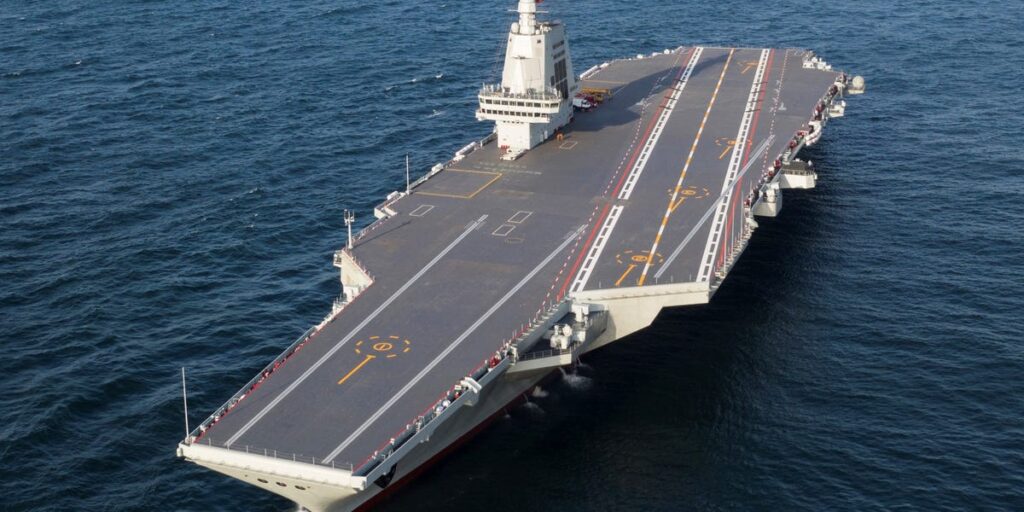China published new footage on Monday of its latest aircraft carrier using an electromagnetic catapult to launch its warplanes, showcasing the use of new naval technology that only the US has so far deployed.
The video clips released by the People’s Liberation Army Navy, or simply PLAN, show its J-35 stealth fighter, J-15T carrier-based fighter, and KJ-600 early warning and control aircraft taking off from its Fujian carrier.
The footage captures some of the advances in naval technology China has made as it strives to build a more formidable fleet on par with the US Navy.
The clips of the Fujian distributed by state media show crews readying warplanes for takeoff, the catapult launches, and aircraft recovery using arresting cables and tailhooks — all elements of modern carrier operations.
“It is remarkable how quickly China has moved from no carriers, to older ski-jump designs, and now to electromagnetic catapults,” Matthew Funaiole, a senior fellow with the China Power Project at the Center for Strategic and International Studies, told Business Insider.
A major technological jump
Pu Haiyang/Xinhua via Getty Images
The Fujian is the Chinese navy’s third aircraft carrier overall and its second domestically made carrier. Considered a substantial improvement over its predecessors, Liaoning and Shandong, Fujian features a flat flight deck with catapults rather than a ski-jump design.
The Liaoning was originally an unfinished hull of an old Soviet warship that China acquired and built into its first carrier. The Shandong was a domestically produced upgrade, but it still bore similar design features.
The Fujian, as shown in the PLAN videos, hosts three electromagnetic launch systems like the ones on the USS Gerard R. Ford, the US Navy’s newest carrier. While the Ford class has electromagnetic catapults, older Nimitz-class carriers are equipped with steam-driven systems for launching aircraft. The US Navy doesn’t use ski-jump designs.
The benefit of a catapult over a ski jump is the ability to launch aircraft regardless of takeoff weight, allowing for the launch of a more diversified air wing, as well as fully fueled and fully armed air assets for greater combat effectiveness. The catapults offer more predictable launches, and the newer electrogmagnetic launch systems are engineered for efficiency.
Launching stealth aircraft
Song Zeyi/VCG via Getty Images
While the US Navy has launched fifth-generation F-35 stealth fighters from Nimitz-class carriers, it has yet to do so from the newer Ford class using its electromagnetic aircraft launch system (EMALS). The PLAN footage indicates that China has become the first country to launch a stealth fighter aircraft off of a carrier with an electromagnetic catapult for flight operations — in this case, the new Shenyang J-35.
The Ford was the first aircraft carrier to deploy with an electromagnetic catapult, but it still hasn’t used it to launch an F-35C, the carrier-based variant of the stealth jet. The ship is not configured or certified for that, though future vessels in the class are expected to be on delivery. The US Navy, however, has carriers available to deploy with combat-proven stealth fighters.
There are engineering hurdles when it comes to catapult launching stealth aircraft off the flight deck of a carrier, both for the launch system and for the planes. Stealth aircraft, for instance, are optimized in a way that doesn’t necessarily lend itself to brute-force reinforcement and need additional engineering to withstand carrier catapult launches and absorb stress.
Previous PLAN reports said China had test-launched a J-35 from the Fujian as early as September 2024, but it did not show the actual takeoff at the time. The new clips released, however, clearly depict a J-35 performing a launch and returning to the deck.
Funaiole said that while the J-35 launch is notable, perhaps the most interesting aircraft in the video is the KJ-600.
The KJ-600 “gives China a capable, fixed-wing early warning aircraft aboard, enabling detection and command well beyond what helicopters or ship radars alone can provide,” he said, adding that the plane “fills a critical gap in China’s naval aviation, allowing its carrier strike groups to see farther and coordinate more complex operations.”
The US Navy fills this role with the E-2D Advanced Hawkeye, an airborne early warning and control aircraft.
Carrier operations
Sun Xiang/Xinhua via Getty Images
The videos released on Monday come as the Fujian heads into its final sea trials before commissioning. The ship was launched in 2022 and has conducted eight trials so far, covering operations such as aircraft launches and propulsion tests. This new Chinese ship’s ninth sea trial is set to assess its long-term mission capabilities.
According to the PLA’s news service, the clips were filmed around September 3, when China celebrated its Victory Day with an audacious parade of its most advanced prototypes and systems yet.
While the Fujian features cutting-edge capabilities, retired US commanders and defense experts previously told Business Insider that it’s hard to say whether the 80,000-ton Chinese ship can truly match the Navy’s aircraft carriers in wartime.
The PLAN is still years behind its American counterpart in terms of experience. The US Navy has extensive experience through both combat and non-combat deployments going back decades. While Beijing has made huge technological progress, effectively mastering aircraft carrier operations is a substantial task in itself.
As Funaiole told Business Insider, tests and training activities like those documented in the video footage are often conducted under the most ideal conditions.
“State-sponsored videos are only going to show you what’s working,” he explained, adding that true operational status means the systems and technologies must work reliably in all weather, at night, and under combat stress.
Even if the PLAN’s carrier crews have more to learn, Funaiole said that “the pace of progress is impressive and underscores how quickly China is modernizing its forces.”


